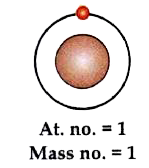The isotopes of neutral atom of an element differ in
electron and proton
neutron and electron
neutron, electron and proton
neutron and proton
The correct Answer is:C
To answer the question "The isotopes of a neutral atom of an element differ in," we will follow these steps:
1. Understanding Isotopes:
Isotopes are variants of a particular chemical element that have the same number of protons but different numbers of neutrons. This means that isotopes of an element have the same atomic number but different mass numbers.
2. Atomic Number and Mass Number:
- The atomic number (Z) is the number of protons in the nucleus of an atom and determines the identity of the element.
- The mass number (A) is the total number of protons and neutrons in the nucleus.
3. Example of Isotopes:
A common example is carbon, which has two stable isotopes: Carbon-12 (C-12) and Carbon-13 (C-13).
- C-12 has 6 protons and 6 neutrons (mass number = 12).
- C-13 has 6 protons and 7 neutrons (mass number = 13).
Here, both isotopes have the same atomic number (6) but different mass numbers (12 and 13).
4. Conclusion:
Therefore, the isotopes of a neutral atom of an element differ in their mass number due to the difference in the number of neutrons.
Final Answer:
The isotopes of a neutral atom of an element differ in their mass number.
---
Isotopes are variants of a particular chemical element that have the same number of protons but different numbers of neutrons. This means that isotopes of an element have the same atomic number but different mass numbers.
- The atomic number (Z) is the number of protons in the nucleus of an atom and determines the identity of the element.
- The mass number (A) is the total number of protons and neutrons in the nucleus.
A common example is carbon, which has two stable isotopes: Carbon-12 (C-12) and Carbon-13 (C-13).
- C-12 has 6 protons and 6 neutrons (mass number = 12).
- C-13 has 6 protons and 7 neutrons (mass number = 13).
Here, both isotopes have the same atomic number (6) but different mass numbers (12 and 13).
Therefore, the isotopes of a neutral atom of an element differ in their mass number due to the difference in the number of neutrons.
The isotopes of a neutral atom of an element differ in their mass number.
Similar Questions
Knowledge Check
The isotopes of an element have
Asame atomic numbersBsame atomic weightsCdifferent atomic numbersDdifferent chemical properties.Which of the following properties of isotopes of an element is different?
AFirst ionisation enthalpyBEffective nuclear chargeCElectron affinityDMelting point and Boiling pointCompounds having the same number of atoms of the same
elements but differ only in the arrangement of the atoms are
called :AisobarsBisostersChomomersDisomers
Assertion (A) : The isotopes are the atoms of the same element with different atomic masses. They require different positions in the periodic table.
Reason (R) : Variable number of neutrons in the nuclei of the atoms of same elements leads to the different atomic masses.
View SolutionIsotopes of an element have
View SolutionA neutral atom of an element has two K, eight L, nine M and two N electrons then electronic configuration of the element is ________
View SolutionIsotopes of an element differ in the number of ………in their nuclei
View SolutionIsotopes of an element differ in the number of ………in their nuclei
View Solution

